Related Research Articles
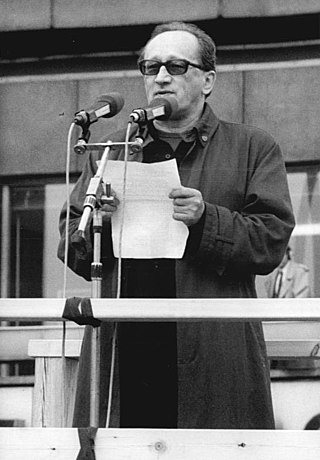
Heiner Müller was a German dramatist, poet, writer, essayist and theatre director. His "enigmatic, fragmentary pieces" are a significant contribution to postmodern drama and postdramatic theatre.
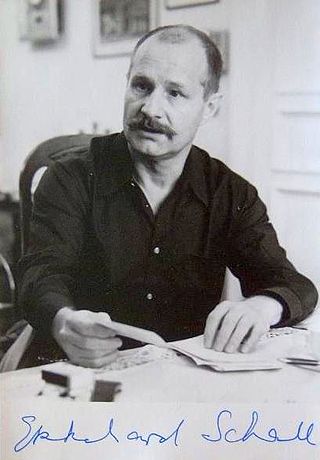
Ekkehard Schall was a German stage and screen actor/director.

Paul Dessau was a German composer and conductor. He collaborated with Bertolt Brecht and composed incidental music for his plays, and several operas based on them.

Bibiana Beglau is a German actress.

Peter Stein is a German theatre and opera director who established himself at the Schaubühne am Lehniner Platz, a company that he brought to the forefront of German theatre.

Benno Besson was a Swiss Theatre Director.
The Lehrstücke are a radical and experimental form of modernist theatre developed by Bertolt Brecht and his collaborators from the 1920s to the late 1930s. The Lehrstücke stem from Brecht's epic theatre techniques but as a core principle explore the possibilities of learning through acting, playing roles, adopting postures and attitudes etc. and hence no longer divide between actors and audience. Brecht himself translated the term as learning-play, emphasizing the aspect of learning through participation, whereas the German term could be understood as teaching-play. Reiner Steinweg goes so far as to suggest adopting a term coined by the Brazilian avant garde theatre director Zé Celso, Theatre of Discovery, as being even clearer.
Carl Weber was a theatre director and a professor of drama at Stanford University. He was Bertolt Brecht's directing assistant and a dramaturg and actor at the Berliner Ensemble theatre company in 1952. After Brecht's death in 1956, Weber remained as a director of the company. He directed in major theatres in Germany, America, Canada and elsewhere since 1957. He produced English translations of German dramatist Heiner Müller.
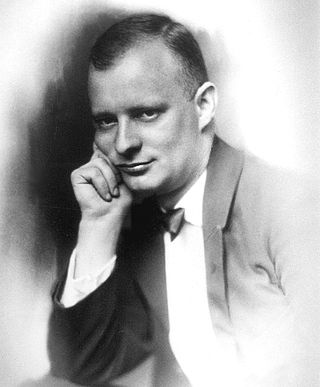
The Baden-Baden Lesson on Consent is a Lehrstück by the German dramatist Bertolt Brecht, written in collaboration with Slatan Dudow and Elisabeth Hauptmann. Under the title Lehrstück it was first performed, with music by Paul Hindemith, as part of the Baden-Baden festival on 28 July 1929, at the Stadthalle, Baden-Baden, directed by Brecht, designed by Heinz Porep.
In the Jungle of Cities is a play by the German modernist playwright Bertolt Brecht. Written between 1921 and 1924, it received its first theatrical production under the title Im Dickicht at the Residenztheater in Munich, opening on 9 May 1923. This production was directed by Erich Engel, with set design by Caspar Neher. The cast included Otto Wernicke as Shlink the lumber dealer, Erwin Faber as George Garga, and Maria Koppenhöfer as his sister Mary. Im Dickicht was produced at Max Reinhardt's Deutsches Theater in Berlin, where Brecht had been employed as a dramaturg. The production opened on 29 October 1924, with the same director and scenographer, but in a cut version with a new prologue and the title Dickicht: Untergang einer Familie. Fritz Kortner played Shlink and Walter Frank played George, with Franziska Kinz, Paul Bildt, Mathias Wieman, and Gerda Müller also in the cast. Willett and Manheim report that this production "was not a success".

Therese Giehse, born Therese Gift, was a German actress. Born in Munich to German-Jewish parents, she first appeared on the stage in 1920. She became a major star on stage, in films, and in political cabaret. In the late 1920s through 1933, she was a leading actress at the Munich Kammerspiele.
Josef Szeiler is an Austrian theatre director. As co-founder of the group Theater Angelus Novus he is first of all known for his experimental approach to texts by Heiner Müller, Bertolt Brecht, Homer and Greek dramas.

Mark Lammert, is a German painter, illustrator, graphic artist and stage designer. He lives and works in Berlin.
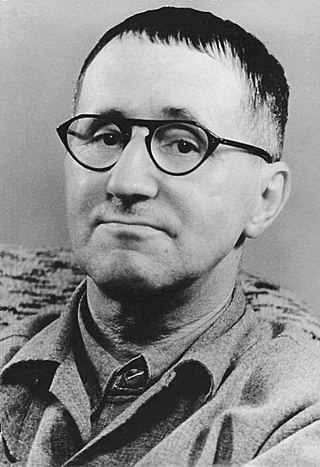
Eugen Berthold Friedrich Brecht, known professionally as Bertolt Brecht, was a German theatre practitioner, playwright, and poet. Coming of age during the Weimar Republic, he had his first successes as a playwright in Munich and moved to Berlin in 1924, where he wrote The Threepenny Opera with Kurt Weill and began a life-long collaboration with the composer Hanns Eisler. Immersed in Marxist thought during this period, he wrote didactic Lehrstücke and became a leading theoretician of epic theatre and the Verfremdungseffekt.
Hans-Joachim Bunge was a German Dramaturg, Director and Author. Bunge became famous through his conversations with Hanns Eisler about Brecht.
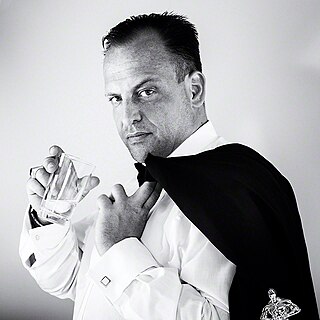
Urs Rechn is a German actor, most famous for his appearance in the 2015 Cannes Grand Prix-winning Holocaust drama Son of Saul.
Quartet, sometimes written as Quartett, is a 1980 play written by the German playwright Heiner Müller.
Andre Asriel was an Austrian-German composer.
Brecht is a 2019 TV docudrama film, dealing with the life and work of the German playwright Bertolt Brecht. A co-production between Bavaria Fiction in Germany, Satel Film in Austria and MIA Film in the Czech Republic, principal photography occurred in and around Prague from 30 May to 28 July 2017. Formed of two 90-minute parts, it was scripted and directed by Heinrich Breloer, with Tom Schilling and Burghart Klaußner in the title role. It premiered at the Berlinale 2019.
Rainer Nägele was an American literary scholar whose research primarily focused on modern German and comparative literature. He was the author of several books, including Reading after Freud: Essays on Goethe, Hölderlin, Habermas, Nietzsche, Brecht, Celan, and Freud. Nägele was the Alfred C. & Martha F. Mohr Professor Emeritus of German Language and Literature at Yale University.
References
- ↑ Brecht 1994, p61. "KOCH/Die Schlacht hat uns/Nicht umgebracht, aber/Bei ruhiger Luft im stillen Zimmer/Bringen wir uns selber um."
- ↑ Brecht 1994, p69/70. "FATZER/Allen Menschen zugleich gehört die Luft und die Straße/Frei zu gehen im Strom der Verkehrenden/Menschliche Stimmen zu hören, Gesichter zu sehen/Muß mir erlaubt sein./Ist doch mein Leben kurz und bald aus und unter den Gehenden/Werde ich nicht mehr gesehen. Selbst im Kampf muß ich atmen/Essen und trinken wie sonst. Vielleicht dauert er ewig/ Nämlich länger als ich, und dann hab ich erschlagen/Überhaupt nicht gelebt. Auch die Brust wird verkümmert/In den Verstecken und wozu noch verbergen/Einen verkommenen Mann. Das alles beweist, daß ich gehen kann/Wies mir beliebt und wohin ich will"
- ↑ Brecht: Arbeitsjournal. Entry from 25 February 1939
- ↑ Brecht: Arbeitsjournal. Entry from 10 July 1951
- ↑ Müller 1982, p. 147
- ↑ Steinweg 1976, p. 73
- ↑ "Das ganze stück, da ja unmöglich, einfach zerschmeißen für experiment, ohne realität! Zur ‚selbstverständigung’". Steinweg 1976, p.77. Orthography and emphasis following the original.
- ↑ Steinweg 1976, p.72
- ↑ See in this respect e.g. Reiner Steinweg’s remarks about theatre as Politaeum at Reiner Steinweg: A 'Theater of the Future'
- ↑ Steinweg 1976
- ↑ Müller 1982
- ↑ Müller 1982, p. 140-149
- ↑ Brecht 1930
- ↑ Steinweg 1976
- ↑ Brecht 1994
- ↑ Schaubühne am Halleschen Ufer, (West) Berlin, 1976; American Premiere, Shelter West Theatre Company, New York City 1978
- ↑ TheaterAngelusNovus, FatzerMaterial Vienna 1985; theatercombinat wien, massakermykene, Vienna 1999/2000
- ↑ FatzerMaterial. Vom Theater ist daher zu sagen, was man vom Körper sagt. University Vienna 1988/89. Documented in Szeiler 1990.
- ↑ "Schaubühne - Chronik". Archived from the original on 16 March 2010. Retrieved 2010-03-29.
- ↑ Brecht 1994
- ↑ Described in Reiner Steinweg: A 'Theater of the Future'
- ↑ Szeiler 1990
- ↑ "Theatercombinat : Massakermykene".
- ↑ "Traces of: Fatzer : Ruhr.2010". Archived from the original on 20 July 2011. Retrieved 2010-04-14.